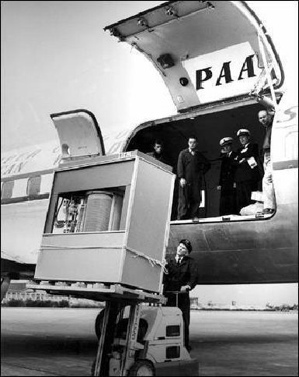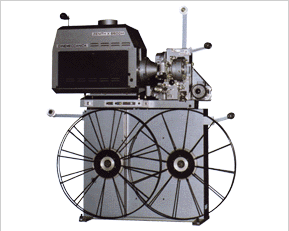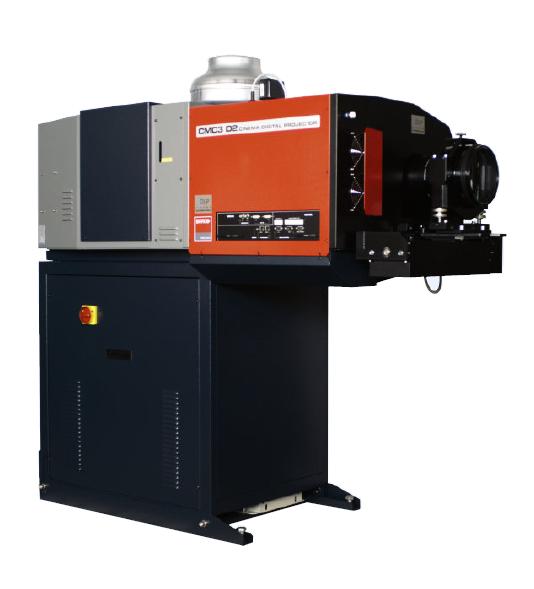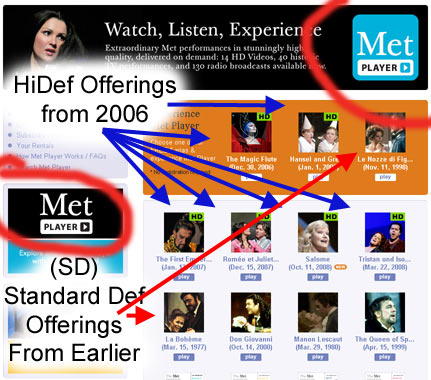Copyright 2009 Mike Strong
Digital Cinema - Movies Gone Digital:
From Film to Digital in the Theaters
- Almost all movies will be digital in the near future
- Digital costs far less to shoot - offering more options (redos) within a budget
- Digital costs far less to distribute - both in terms of film stock and transportation
- Digital costs far, far (and far) more to preserve than film
- Digital doesn't last as long as film - modern "safety" film that is
Cost of film
Shooting film has always been costly. Smaller film sizes allowed more work to be done on the same budget but there was always the business of buying film, exposing and developing film, editing film (sometimes on prints, to save the camera originals) and printing on more film from the masters. Each time a film was sent out for distribution to theaters only so many copies could be made within budget so theaters showed the film for a while and them sent it on to the next theater in line. After a few showings the film would become so deteriorated (vertical scratch lines called cinch marks, dust and dirt) that a new print would have to be produced. Each print cost averages about $1,200 (US). At that rate distributing even to a thousand theaters costs $1.2-million. A wide release movie could need 4,000 or more prints - that would mean $5-million or more dollars just for the prints, and they won't last a long time.
Distribution
Digital, on the other hand, can be distributed to a huge number of theaters at one time. Digital doesn't deteriorate with each showing. Digital has enough detail now to be indistinguishable from film, for the most part, or tolerated by audiences if not. A theater can change their offerings on a dime with digital, either extending a showing period or poping something else into the theater or offering live broadcasts. With digital projectors an entire set of markets in theaters can be opened up to low-cost local and other productions. And digital can go directly into DVDs without having to convert from film. Distribution could be done either on hard drive (a 320 gigabyte drive could hold a standard feature film at less than $100 each, and drives are returnable and re-usable) or by the internet costing pennies for transport and being stored on a hard drive at the theater.
Copyright and copying and pirate problems rear their head and require further remedies. One of the advantages of digital distribution is the ability to have universal wide release for a reasonable cost. In most cases with film, releases start in some theaters and over a period of time move to other theaters as the prints are shipped around. This allows time for pirate versions to circulate before the distribution to all theaters is done. This allows at least some forms of piracy to be cut off at the pass. In addition the digital form means that full-quality DVDs can be released by the studio at the same time as the theatrical release, even at the theater, or at any time after the original release date. This means that the studio / moviemaker has a better chance to grab all channels of distribution. This doesn't take into account the piracy which occurs in studios and which seems to be the real major problem in large-scale piracy.
Costs for Re-Fitting
Digital cinema projectors for theaters have come down dramatically in price over the last half decade or so but compared to film projectors the costs remain high. Film projectors for a theater can run 35,000 to $50,000 and can last for three or four decades in good condition - or a cost of a $1,250 to $1,700 a year. Digital projectors for theaters might have cost close to a third of a million dollars just a few years ago and were recently in the order of $150,000 to $200,000. DIgital projectors installed in the Omaha area in 2006 and 2007 were in the range of $70,000 to $83,000. Each of those projectors also require a server (computer) running about $20,000. The major caveats for digital projectors are about component failures and becoming obsolete within five years or so before they need to be replaced. With rapid technical changes the entire system needs to change over. With luck the prices will continue to go down, making the change less onerous.
This had made theaters reluctant to pony up re-fitting costs without sharing some of the expense with distributors. Negotiations have seen the creation of something called the Virtual Print License fee. The studios pay for this which helps to pay for digital projection systems.
It should be noted that small theaters and art houses often use standard commercial digital projectors to screen movies. These are seldom more than a couple of thousand dollars and look just fine. Often, no one even notices.
One more route is genuine large emmision screens, rather than projectors. OLEDs (organic light emitting diodes) have been a prime suggestion for this possibility. There are still a number of technical problems and most OLED screen are small. To date the most common place you would have seen OLEDs used in in the screen of your cell phone. The promise is that ink-jet printers could actually print OLEDs to a substrate making them incredibly cheap and versatile to produce.
Cost of Storage
IBM 5-megabyte hard drive 1956 - yes, this is a real photo of a real deviceIn seems counterintuitive that digital storage costs would be far more than film storage costs but there are several reasons for this and it directly affects how many movies will be preserved for the future.
In the Kansas City area we have massive underground storage vaults, old limestone mines and old salt mines which store very important archives because their environment is so stable. Pennsylvania also has such old limestone mines which are now used as storage facilities.
Storing the camera negatives, still pictures, audio recordings, scripts and the other items which are part of a film movie's production costs a little less than $500 per year. Storing the film master runs about $1,000 a year. Storing a digital master runs about $12.5-thousand a year. And storing all the extra stuff generated as digital data when a digital movie is made can run more than $200,000 year.
In terms of physical preservation all movies made in digital are also being stored on a film print for archival protection and are expected to last, as film, for a century or more.
Digital storage, compared to analog, is very volatile. Hard drives can freeze up (figure two year usable life doing nothing), DVDs degrade at a half-life of about 15 years. When digital media degrade they become unreadable. When analog media degrade they just look or sound worse but are still recognizable. To keep digital media readable they must be refreshed every so many years by copying them from one storage medium to another storage medium. Plus that, the software and the hardware used to read the digital data may become un-available, leaving the old data un-available.
Further, digital shooting, because it is less expensive, and digital editing, because more options can be available, generates a huge amount of extra data to store, although it may never show up in any release.
Work Flow Change - to Playlists Film projectors had two types of workflow depending on the type of projector.
Side-by-side projectors
For single screen theaters and various other theaters with two projectors for a screen, the two projectors stand side by side and the entire film is played by alternating between machines for each reel of film. A reel of film is 20 minutes long. As the reel ended on one machine the projectionist would get ready to start the other machine. At the one-minute mark before the end of the reel a bell dings and small red dots are flashed on screen in the upper right corner. The dots are called "cigarette burns." This was the projectionist's signal to start the other projector.
In the time between projector switches the projectionist must rewind the just finished reel so it will be ready for the next time it is played and must load the projector with the next reel in the film.
Platters and polyester film base
35mm film projector with the supply and take-up reels belowIn the late 1970's when mulitplexes first came along polyester base film replaced the older acetate. Polyester is both stronger and more flexible, greatly reducing film breaks. Polyester made the platter system possible. In a platter system all the reels of film are put together and the film runs horizontally (across) the projection room.
The platter is put together the night the movie theater receives the reels of film. All the reels are spliced together along with any previews and ads. When done, usually at least an hour to prepare, it will weigh more than 200 pounds. In preparing the platter metal strips are added to the film. The metal strips cue the house lights to go fade down or fade up. You can also run two projectors at a time by extending the film run across the projectors (up to about 30 feet), meaning that a multiplex can start the same movie, with the same film, at pretty close starting times.
Hard Drives and Playlists
Between satellite and internet the most common distribution at the moment is still physical, just smaller. A standard hard drive is delivered. Their are concerns that a central downloading system can be broken into by pirates. The hard drives (at about $100 or less each for a feature-length film) are re-usable, smaller, and provide a media source which won't scratch (cinch marks) fade, burn from projector bulb heat or catch dust. And, no projector to thread.
Instead you can use a computer to quickly put together a playlist which includes trailers, ads and the feature, not to mention house-light cues.
Cinemeccanica Digital Cinema Projector
The advertising information is copied from:
http://www.cinemeccanicaequipment.com/Cinemeccanica-Projector-Parts.htmlNote that:
1 - Tthe equipment is advertised as a similar physical match for the 35mm equipment most theaters already have.
2 - The advertised maximum resolution of 2048x1080 is only a little more than current HiDef television at 1920x1080
3 - Optional anamorphic lens - indicating that the 1920x1080 format can be horizontally extended using optics to compress and then expand the image (like film + video).
4 - Space in the cabinet to mount a computer to store and deliver the digital files (rack space ... to mount the server)Here is text from Cinemeccanica. The boldface is my own emphasis.
The latest addition to the arsenal of Cinemeccanica projectors is the CMC3-D2 Digital Cinema Projector. It is bright, reliable and is designed around existing 35mm architecture to make it easily accessible to the world of cinema technicians already available to your theatre
Digital projector with three 2K DLP TM Cinema chips
- Max resolution 2048x1080 - Contrast ratio up to 2000: 1
- Light output up to 23.000 ANSI Lumen (measured in operation with 1.8 screen gain)
- Totally sealed optics to insure stability over time
- Automatic mechanical dowser
- Zoom primary lenses of different focal lengths approved by DLP TM cinema
- optional anamorphic lens approved by DLP TM cinema with motorized and totally automatic holder or with manual lens holder
- optional videoscaler to show alternative contents
- linear or electronic rectifier to supply xenon bulbs up to 6000W
- touch screen control panel
- rack space at the back to mount the server
- fully self aligning xenon bulb system
- optional spherical auxiliary mirror to cover very large screens.
http://www.cinemeccanica.it
http://www.cinemeccanica.it/eng/indexnoflash.htm
Alternative content
With digital theaters have the ability to show live events, generate more extensive pre-show advertising locally, and local content from video/film clubs and artists as well as local arts companies' performances. This also allows low-budget productions to start with a small distribution at affordable costs. If their movie begins to take off the distribution can be ramped up to more outlets without significant extra costs (avoiding film print costs).
We need to remember that before the days of home video equipment movies basically came to the theater, played, and then disappeared into the company vaults, usually not coming out again. Some movies were printed on home stock, 8mm or super 8 film and projected at home. But most people didn't have a movie projector. Television was the first real break, giving a new market for those movies in the vault as a part of the broadcast schedule of either stations or networks. Once home video became affordable movies had yet another new market and could be watched again and again whenever the video owner wanted. DVDs just extended that market.
Stage performances are even worse than film in terms of permanence because they are often either not recorded or recorded poorly. So, streaming media and download sales offer a marvelous distribution mechanism to make these performances available to a wide audience and provide income for the originating organization at the same time.
Direct To Video as VOD - Video On Demand It used to be that when a movie was so bad it was expected to die in the movie theaters, it would go directly to video, tape or DVD. No bad reviews. No expensive distribution. Just video sales. But HiDef streaming has changed the game. Now Stephen Spielberg is going direct to Video-On-Demand.
OEM Media Players OEM (original equipment manufacturer) equipment has been around a long time. This is equipment, or software or some other product which is labeled at the factory with the brand name of the selling company. That is, some manufacturer makes parts or appliances or other products for various companies, each of which puts their own brand on the product and sells it.
Streaming services are now doing the same trick. Move Networks http://www.movenetworks.com/
is selling streaming services, using their own streaming application which needs to be downloaded and installed by each client of the client. Note the information about the Metropolitan Opera just below. At the same time the player subscription allows the seller to control how much access to material each subscriber or renter can have.
Move Networks Move Networks lists among its clients, ABC, Discovery, Fox, The CW, Televisa, ESPN 360, Oprah and the Metropolitan Opera. All of these outfits are using the same player with differing "skins" for a customized appearance.
The Move player follows in the same model as Real Player, Windows Media Player and the QuickTime Player in that it is a small plugin for the browser. Plugins are programs used within or called from other programs to perform support tasks. 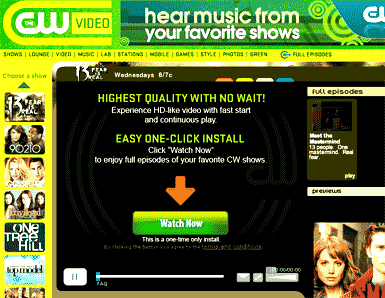
Move Networks sets up its source files by encoding the media files into segments, each having different qualities. Some are high quality and some are low quality. Depending on the download speed during streaming, different versions of a segment (called "streamlets") are sent. The faster the connection, the higher the quality. This concept is also called "adaptive streaming" which merely means that the quality of the stream changes during the download, depending on the maximum speed possible at any time.
Adaptive Streaming also allows Move Networks to send a media stream designed for the type of device it will be played on.
- Move Networks sends media streams to
- cell phones
- computers
- televisions
Reporting To The Client
While you are watch media, the media player is watching you and sending a set of data back on what you are doing: The player plugin records (among other things):
1 - what you watch
2 - how long you watch
3 - where you are when you are watching
4 - when you watchAt the same time the player is generating information which goes to billing and beign able to establish the return on investment. This depends on whether the publisher of the media is getting money from ads or subscriptions or rentals and so forth.
New York's Metropolitan Opera
The Metropolitan Opera has long been one of the leading users of each new media in turn, to expand their presence in the country and the world as well as to expand appreciation and understanding for their medium. The use of Move Networks is just one of the latest methods they have used in the century and a quarter of their existence.
For nearly eight decades the Met has broadcast on ratio. The first complete opera to be broadcast from the Met was on the 25th of December 1931, Hansel und Gretel. The Met maintained saturday afternoon broadcasts from December through April. The radio broadcasts now go to 42 countries. They are also now on SIRIUS Satellite Radio.
They began a regular television series in 1977 “The Metropolitan Opera Presents.” Many of those recordings were later distributed on videotape and DVD. Even Laserdisc recordings. The Met has a regular public television show. In 2006 the Met launched live, HiDef broadcasts to more than 600 theaters
in the North America, Europe, Asia and Australia.
Online, viat the internet, the Met also provides streamed audio via Rhapsody, and free live audio streaming of performances on its website once every week during the opera season using RealNetworks®.
Then we come to home theater and the Met Player. This is right in tune with the latest evolution in media delivery, HiDef to the home screen. NetFlix has been doing this for some time, in addition to its DVD postal deliveries. The Met contracted with Move Networks to use a player they can brand with their own name.
On this page the Met markets its performances for download and play. The arrows and red circles are mine (of course). The page looks much nicer than this. http://www.metoperafamily.org/met_player/index.aspx
Note three items:
1 - The player (circled in red)
2 - The Hi Definition offerings. (blue arrows) These start with 2006 productions.
3 - Older offerings in standard definition. (red arrows) A great way to use their archive material which would otherwise disappear.
New York's Metropolitan Opera has been using its performance footage to gain extra play and greater presence in the country and anywhere the internet extends. They are using the Move Networks player (branded as the Met Player) to re-sell performances in full definition video, both standard def and the newer high def format. Look at the prices below and then note the conditions. They are now able to reach far beyond both their concert hall, or other venues and far beyond their performance schedule.
The Met is among the first performance companies to do this. Yearly Subscription
The Met's "Watch and Listen" webpage http://www.metoperafamily.org/metopera/broadcast/on_air.aspx
A year for the price of 10 months Monthly Subscription Opera Rental Free Trial
Prices (as of Jan 2009) for Performance Video from the Met Subscribe for one year $149.99 Subscribe for one month $14.99 Rental - standard def $3.99 Rental - HiDef $4.99 7-day Free Trial Free ** If you think about the cost of a family's tickets or a couple plus transportation, parking, meal in a nice spot before or after and sales items before the show and during intermission, these are pretty low prices for high quality, on demand, performances from one of the best opera companies in the world.
Extra Link Resource
http://www.curzon.org.uk/collection/35Kalee11.html
http://www.videointerchange.com/video-history.htm
